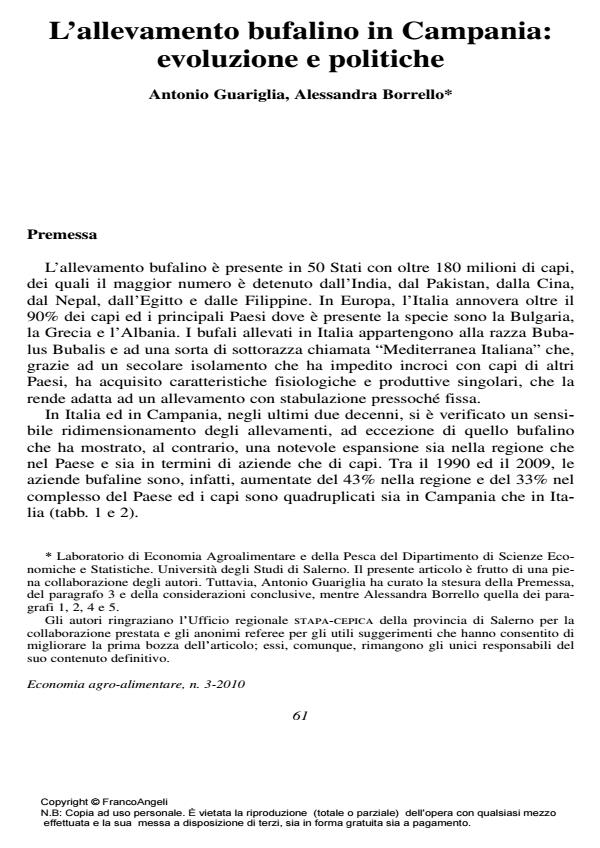Buffalo rearing in Campania: evolution and policies
Journal title ECONOMIA AGRO-ALIMENTARE
Author/s Antonio Guariglia, Alessandra Borrello
Publishing Year 2011 Issue 2010/3
Language Italian Pages 26 P. 61-86 File size 373 KB
DOI 10.3280/ECAG2010-003004
DOI is like a bar code for intellectual property: to have more infomation
click here
Below, you can see the article first page
If you want to buy this article in PDF format, you can do it, following the instructions to buy download credits

FrancoAngeli is member of Publishers International Linking Association, Inc (PILA), a not-for-profit association which run the CrossRef service enabling links to and from online scholarly content.
This note will examine: 1) the size and location of buffalos and buffalo farms in the Italian regions over the past decades; 2) the evolution of some structural and technological characteristics of the buffalo farms in a particular area around the river Sele, called Piana del Sele, where, at the end of World War II, there were the largest part of the last twelve thousand animals survived the war and where the modern farming system was born; 3) the major and most recent zootechny policies implemented in the Campania Region; 4) the reasons why only a small percentage of buffalo farms has received the incentive provided by the Region for the farm modernization; 5) the compatibility between the factors of evaluation, used by the measures 4.8 of the por 2000-2006 and 121 of the psr 2007-2013 for the reception of farmers’ applications, and the characteristics of the buffalo sector. During the period 1990-2009, there was a strong decrease of Italian farms with cattle, pigs, sheep, goats, horses, poultry and rabbits. Except in the case of pigs, there was a reduction also in terms of animals but its percentage value is smaller, indicating a general phenomenon of production concentration. Regarding the Italian buffalo industry, by contrast, both farms (33%) and animals (317%) have increased and the number of regions involved in this kind of activity has grown from 4 (1980) to 19 (nowadays), while the provinces have increased from 8 to 84. The Campania region has always held the leadership of the sector; in 2009, the number of buffalo farms in Campania represented the 55.5% of the Italian value and the share of buffalos, reared in the region, was 71.6%. In addition, from 1990 to 2009, the average number of buffalos per farm almost tripled (from 56.1 to 161.9). At national level, the analogous index increased from 40.1 to 125.6. In order to study the evolution of some structural features and technologies, the analysis focused on the province of Salerno and, in particular, on the above mentioned area around the river Sele; therefore, a survey was carried out in that district by administering a questionnaire to n. 100 entrepreneurs of the sector, chosen with a non-probability quota sampling. Only 7% of the buffalo farms in the province of Salerno have received incentives within the measure 4.8 of the por Campania 2000-2006; after 16 months from the first call of the measure 121 of the psr, buffalo farms’ applications are only 4.0% of the total. That is why it seemed necessary to examine whether the assessment factors of the two measures were and are compatible with the requirements of farmers and farms of the sector we are studying and whether investments planned for farm modernization by those measures were and are compatible with the needs of such industry; therefore, it was administered a questionnaire on the factors of assessment used by the two measures to 20 privileged witnesses. Through a structured technique for dealing with complex decisions, the Analytic Hierarchy Process (ahp), a specific weight was attributed to each factor of assessment in terms of its importance and according to the preferences expressed by the actors interviewed. The weight values resulting from the analysis are closer to those used for the por than to those used for the psr. The incentive scheme, based on capital contribution (40-60%), was indicated by farmers as the main impediment to the use of resources for farm modernization by buffalo farms, as it was and is more suitable for firms with a greater economic dimension. It is, therefore, desirable to also introduce interest subsidies with certain maximum rates paid by farmers. It should also be carefully evaluated the convenience of using different assessment factors for the various sectors of the regional agriculture, in order to better compare the applications among each other, make ranks and provide that investments go in the direction of the actual and urgent needs for the modernization of the different production processes that exist in the Campania region.
Keywords: Buffalo farm, rural development policy, cap, Analytic Hierarchy Process
Jel codes: Q28, Q18
Antonio Guariglia, Alessandra Borrello, L’allevamento bufalino in Campania: evoluzione e politiche in "ECONOMIA AGRO-ALIMENTARE" 3/2010, pp 61-86, DOI: 10.3280/ECAG2010-003004